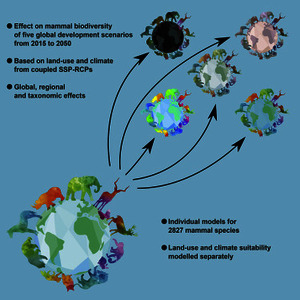Baisero, D., Visconti, P.  ORCID: https://orcid.org/0000-0001-6823-2826, Pacifici, M., Cimatti, M., & Rondinini, C.
(2020).
Projected Global Loss of Mammal Habitat Due to Land-Use and Climate Change.
One Earth 2 (6) 578-585. 10.1016/j.oneear.2020.05.015.
ORCID: https://orcid.org/0000-0001-6823-2826, Pacifici, M., Cimatti, M., & Rondinini, C.
(2020).
Projected Global Loss of Mammal Habitat Due to Land-Use and Climate Change.
One Earth 2 (6) 578-585. 10.1016/j.oneear.2020.05.015.
Preview |
Text
1-s2.0-S2590332220302517-main.pdf - Published Version Available under License Creative Commons Attribution Non-commercial No Derivatives. Download (1MB) | Preview |
![1-s2.0-S2590332220302517-fx1.jpg [thumbnail of 1-s2.0-S2590332220302517-fx1.jpg]](https://pure.iiasa.ac.at/16526/2.hassmallThumbnailVersion/1-s2.0-S2590332220302517-fx1.jpg)  Preview |
Image
1-s2.0-S2590332220302517-fx1.jpg - Graphical Abstract Available under License Creative Commons Attribution Non-commercial No Derivatives. Download (49kB) | Preview |
Abstract
Human pressure on the environment is driving a global decline of biodiversity. Anticipating whether this trend can be reverted under future scenarios is key to supporting policy decisions. We used the InSiGHTS framework to model the impacts of land-use and climate change on future habitat availability for 2,827 terrestrial mammals at 15 arcmin resolution under five contrasting global scenarios based on combinations of representative concentration pathways and shared socio-economic pathways between 2015 and 2050. Mammal habitat declined globally by 5%–16% depending on the scenario. Africa (with declines up to 25%) and South America were the most affected regions. African insectivores, primates, Australian carnivorous marsupials and marsupial moles, and South American opossums declined the most. Tackling this loss would require a mix of actions across scales, including a global shift toward sustainability, addressing land-use change in sub-Saharan Africa, and helping endemic species track climate change in South America.
| Item Type: | Article |
|---|---|
| Research Programs: | Ecosystems Services and Management (ESM) |
| Depositing User: | Luke Kirwan |
| Date Deposited: | 22 Jun 2020 12:38 |
| Last Modified: | 13 Aug 2025 05:00 |
| URI: | https://pure.iiasa.ac.at/16526 |
Actions (login required)
 |
View Item |
 Tools
Tools Tools
Tools